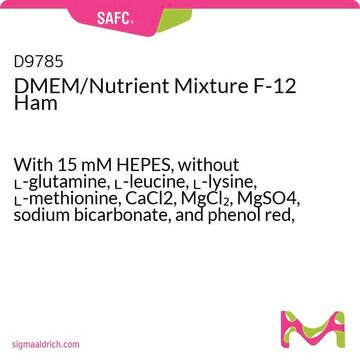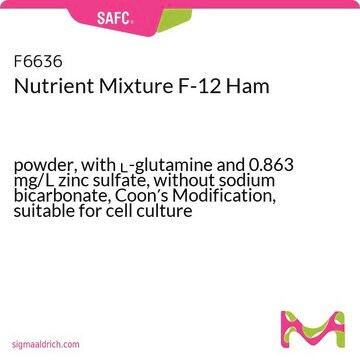D2906
DMEM/F-12
With ʟ-glutamine, sodium pyruvate and HEPES, without sodium bicarbonate and phenol red, powder, suitable for cell culture
Synonyme(s) :
DME/F-12, mélange 1/1
About This Item
Produits recommandés
product name
Milieu de Eagle modifié par Dulbecco (DMEM)/Mélange nutritif F-12 de Ham, With L-glutamine and 15 mM HEPES, without sodium bicarbonate and phenol red, powder, suitable for cell culture
Niveau de qualité
Forme
powder
Technique(s)
cell culture | mammalian: suitable
Composants
NaHCO3: no
L-glutamine: yes
phenol red: no
sodium pyruvate: 0.055 g/L
glucose: 3.15 g/L
HEPES: 15 mM
Conditions d'expédition
ambient
Température de stockage
2-8°C
Vous recherchez des produits similaires ? Visite Guide de comparaison des produits
Description générale
Application
- Hep-2 cells
- mouse fibroblast L‐cells
- L‐ Wnt family member 3A (Wnt3a) cells
- primary buffalo embryonic fibroblast (BEF)
Quantité
Reconstitution
Souvent commandé avec ce produit
Supplément
Code de la classe de stockage
11 - Combustible Solids
Classe de danger pour l'eau (WGK)
WGK 1
Certificats d'analyse (COA)
Recherchez un Certificats d'analyse (COA) en saisissant le numéro de lot du produit. Les numéros de lot figurent sur l'étiquette du produit après les mots "Lot" ou "Batch".
Déjà en possession de ce produit ?
Retrouvez la documentation relative aux produits que vous avez récemment achetés dans la Bibliothèque de documents.
Les clients ont également consulté
Notre équipe de scientifiques dispose d'une expérience dans tous les secteurs de la recherche, notamment en sciences de la vie, science des matériaux, synthèse chimique, chromatographie, analyse et dans de nombreux autres domaines..
Contacter notre Service technique







